The forward helix piercing—also known in anatomical terms as the anti-helix—is a delicate and stylish accent that elegantly follows the upper, forward curve of the ear. As a cornerstone of modern ear curation, it can be worn as a single, subtle statement or arranged in a stunning double or triple cascade. At Pink Tatpier, our London piercing specialists are experts in the precise placement and artistic arrangement of this popular piercing, transforming it into a beautiful feature of your unique style.
Executing a perfect forward helix, especially a multiple one, requires more than just a steady hand; it demands an artist’s eye for alignment and a deep understanding of ear anatomy. Our process is built on this foundation of expertise, ensuring every piercing is not only safe but perfectly placed to create a harmonious and balanced look.
Discover our meticulous procedure, get a transparent price for your single or multiple forward helix piercing, and book your appointment online today with London’s curation specialists.
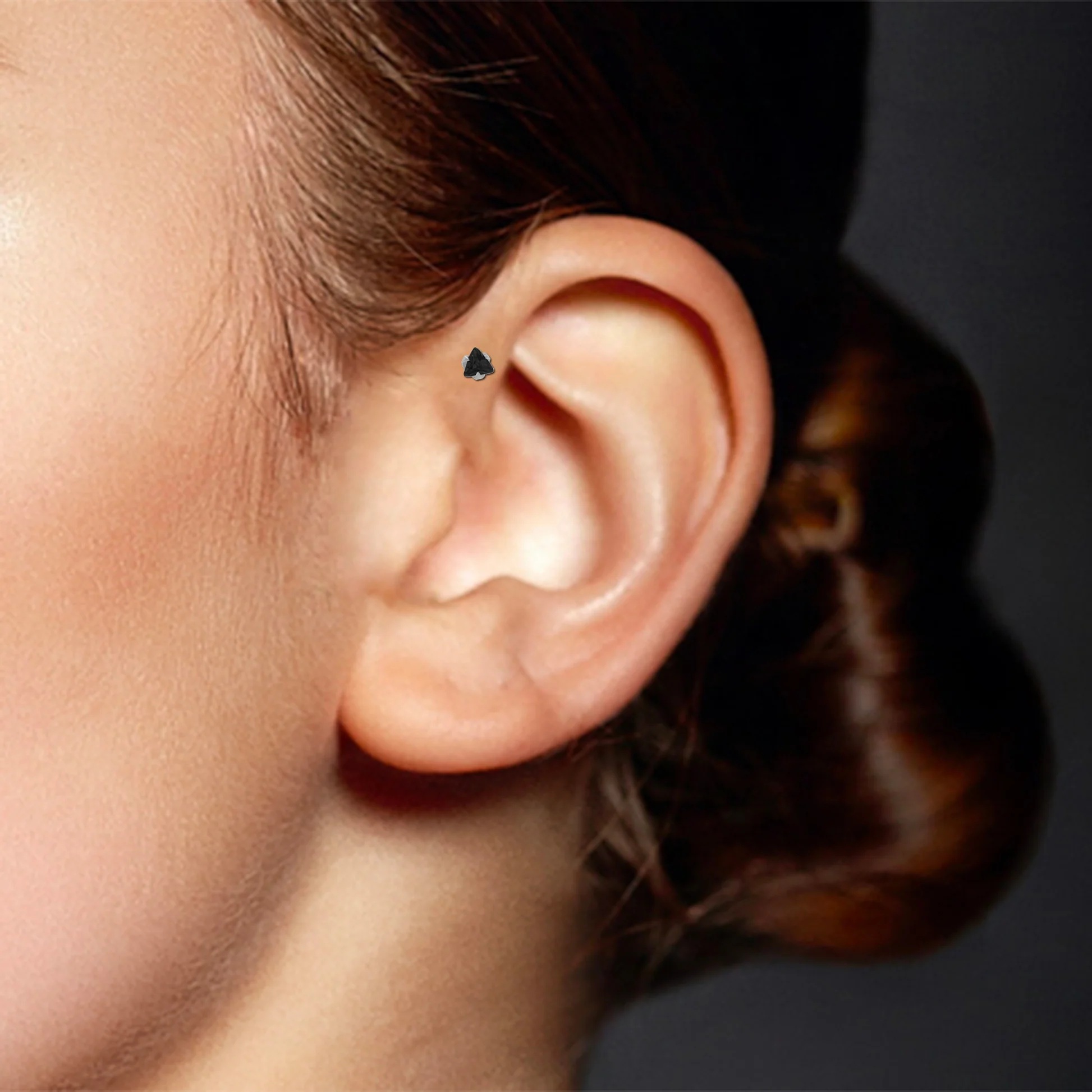
Anti-Helix Piercing
Anti-Helix vs. Forward Helix: Clarifying the Terminology
Before we dive in, let’s clear up a common point of confusion. In the professional piercing world, you’ll often hear this piercing called by two names:
- Anti-Helix: This is the correct anatomical term for the forward-facing rim of cartilage.
- Forward Helix: This is the more common, popular, and widely used name for the piercing.
They refer to the exact same placement: the outer rim of cartilage at the front of the ear, located just above the tragus. We are specialists in this piercing, whichever name you prefer to use! For clarity, we will refer to it as the forward helix for the rest of this guide.
Is a Forward Helix Piercing Right for You? The Anatomy Check
While the forward helix is suitable for many people, a successful and well-healed piercing is dependent on having the right anatomy.
Assessing Your Cartilage Ridge
A viable forward helix piercing requires a defined ridge of cartilage with enough of a flat “shelf” to support the back of the jewellery. If this ridge is too thin, too shallow, or curves back too sharply, it may not be possible to pierce it safely.
For double and triple forward helix projects, this anatomical requirement is even more crucial. The ridge must be large enough to accommodate multiple piercings with proper spacing to allow for swelling and to prevent them from putting pressure on each other during the healing process.
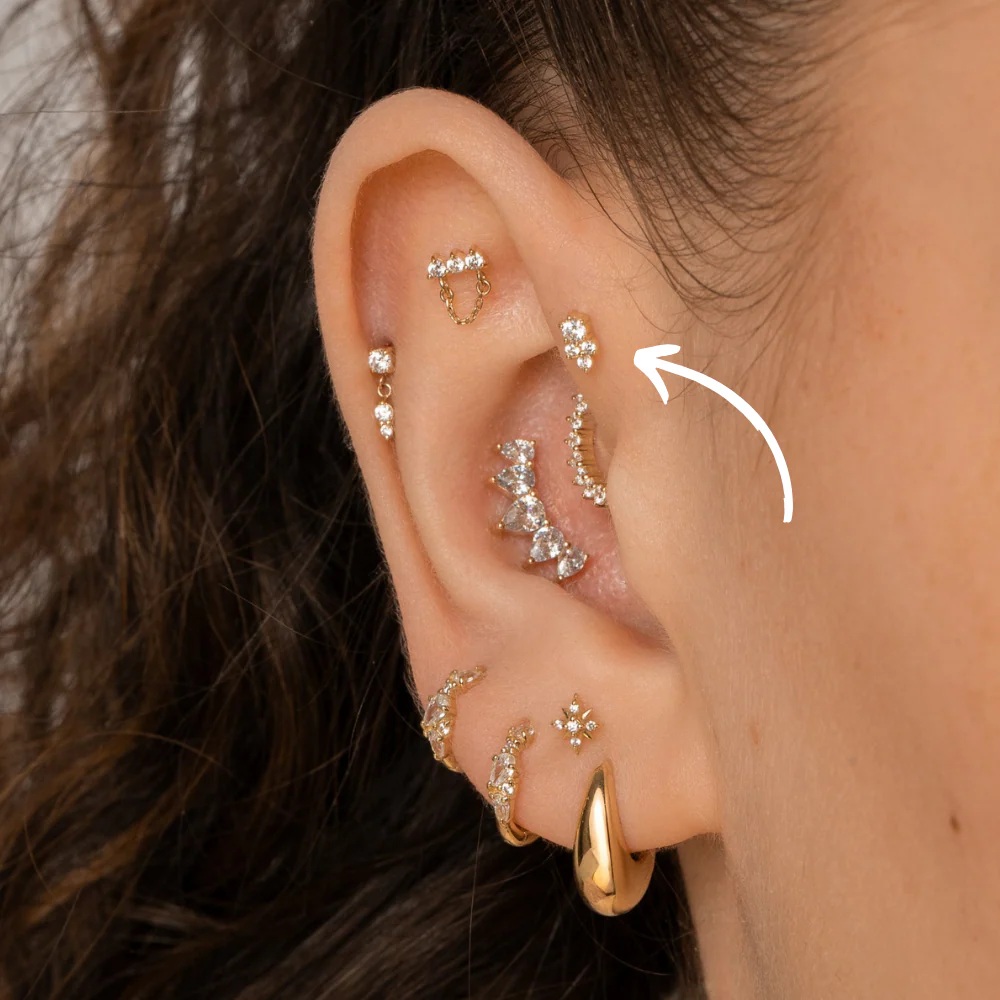
Anti-Helix Piercing
Our Professional Assessment Promise
At your Pink Tatpier consultation, the first step is always a thorough assessment of your ear’s unique structure. Our expert piercer will carefully examine your helix ridge and provide an honest, professional recommendation on whether a single, double, or even triple forward helix is a safe and viable option for you. Our goal is to ensure a beautiful and well-healed result, and that starts with an honest conversation about your anatomy.
The Art of Curation: Single, Double & Triple Forward Helix
The true beauty of the forward helix lies in its potential for creative arrangement.
- Single Forward Helix: A single stud in this position is a statement of minimalist elegance. It’s a perfect, delicate addition that draws attention to the front of the ear.
- Double & Triple Forward Helix: This is where artistry truly comes into play. Creating a perfect double or triple forward helix is a feat of precision. Our piercers meticulously mark the placements to ensure they are perfectly spaced and follow the natural curve of your ear. We can create a classic, evenly-spaced look or a more dynamic “cascade” effect using graduating jewellery sizes for a stunning, curated aesthetic.
The Forward Helix Piercing Process: A Guide to Your Appointment
- Consultation & Anatomy Check: We discuss your goals and our piercer assesses your anatomy to confirm the viability of your desired piercing(s).
- Jewellery Selection: You’ll choose your initial jewellery from our extensive collection of implant-grade, flat-back labret studs.
- Artistic Marking: This is a crucial step, especially for multiples. Your piercer will carefully mark the placement(s) and you will approve the final look in a mirror.
- The Piercing Procedure: The piercing itself is very quick, performed with a sterilised, single-use needle.
- Jewellery Insertion & Aftercare: The jewellery is inserted, and we provide you with a comprehensive aftercare plan.
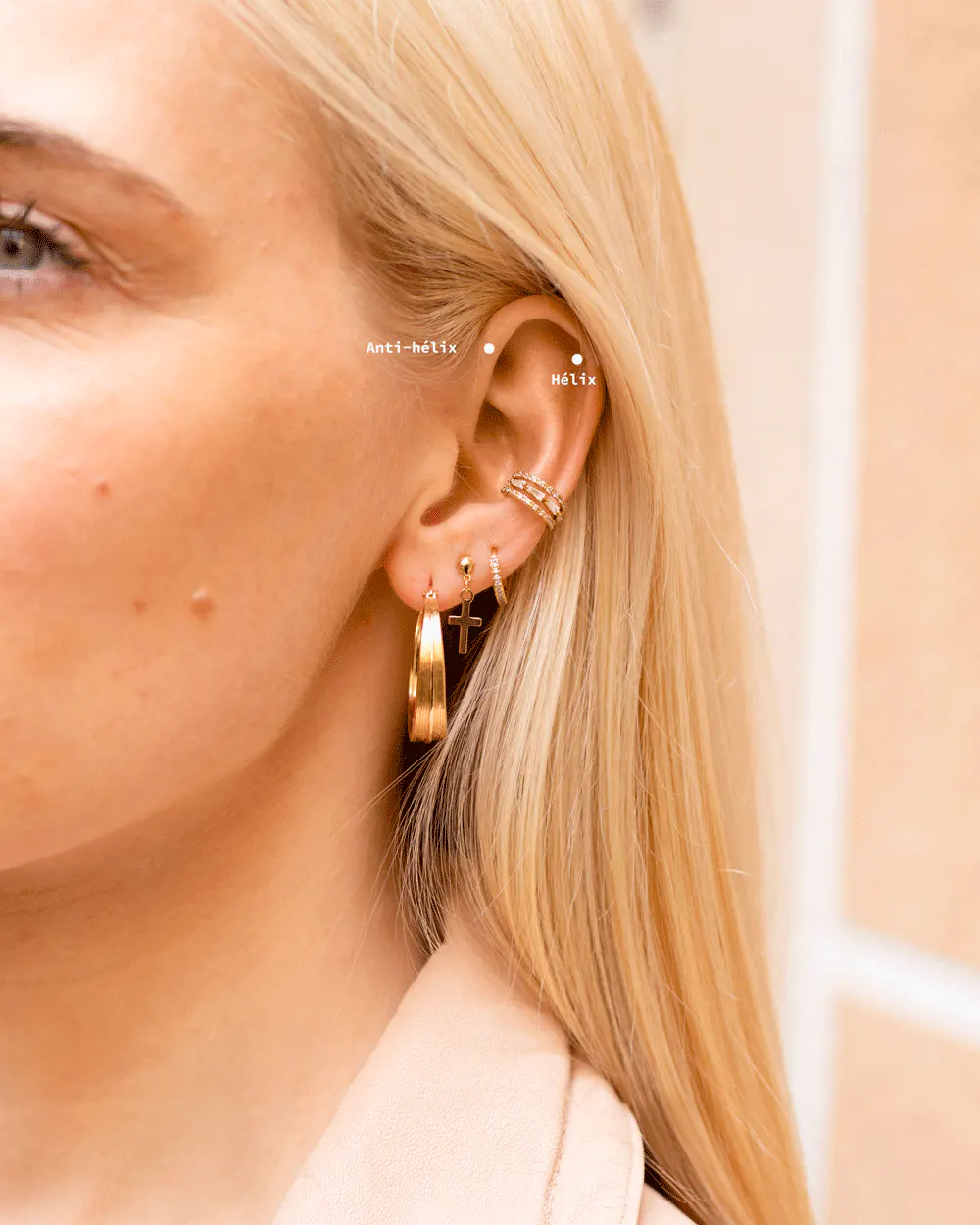
Anti-Helix Piercing
Forward Helix Piercing Price, Pain & Healing: Your London Guide (September 2025)
Pain Level
The forward helix is a cartilage piercing, so you can expect a sharp pinch. Most clients rate the pain at a 5-6 out of 10. It is generally considered less intense than a daith or rook piercing. If you are getting a double or triple in one sitting, expect the second and third piercings to feel slightly more intense than the first.
Healing Time
Patience is key. A forward helix piercing will take approximately 6 to 9 months, and sometimes up to a year, to heal fully. Its location makes it particularly prone to being snagged by hair and bumped by glasses, which can prolong the healing process.
Cost of a Forward Helix Piercing in London
Our pricing is transparent and charged per piercing.
| Service | Price (GBP) | What’s Included |
| Forward Helix Piercing Fee (per piercing) | £35 – £45 | A professional consultation, anatomy assessment, sterile procedure, and a comprehensive aftercare guide. |
| Initial Jewellery (Stud) | Starts from £20 | An implant-grade titanium flat-back labret stud. Price varies for solid gold and genuine gemstones. |
| Total Starting Price (per piercing) | From £55 – £65 | The service fee + the cost of your chosen jewellery. |
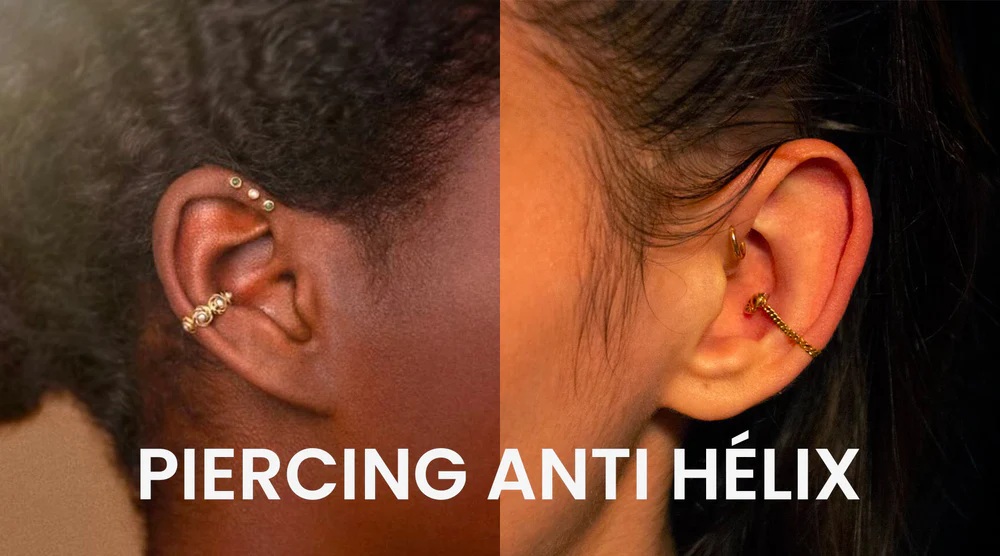
Anti-Helix Piercing
The Best Jewellery for Your Forward Helix Piercing
For Initial Healing: Flat-Back Labret Studs
For the entire initial healing period, the only appropriate jewellery is a flat-back labret stud.
- Why? Hoops and rings move too much, which causes constant irritation to a healing forward helix, leading to bumps, swelling, and a much longer healing time. The flat back of a labret stud sits flush against the back of the piercing, minimising snagging and promoting a stable healing environment.
For a Healed Piercing
Once your forward helix is fully healed, you can explore a world of beautiful jewellery options. You can be fitted for a tiny, snug-fitting seamless ring or hoop, or you can choose from our vast collection of decorative ends for your labret post, including tiny gemstones, clusters, chains, and unique shapes.
Materials Matter
We only stock and use the safest, implant-grade materials for your peace of mind:
- Implant-Grade Titanium (ASTM F-136)
- 14k & 18k Solid Gold (Nickel-Free)
Professional Aftercare for a Happy Forward Helix
- DO clean the piercing twice daily with a sterile saline solution.
- BE VERY CAREFUL WITH HAIR AND GLASSES. This is the number one challenge with this piercing. Keep your hair tied back as much as possible, and be mindful when putting on or taking off glasses or masks.
- DO NOT sleep directly on the piercing. Use a travel pillow and place your ear in the hole to avoid any pressure.
- DO NOT twist, turn, or play with the jewellery.
- DO consider returning for a downsize appointment after 4-6 weeks to have a shorter bar fitted if necessary.
Frequently Asked Questions About Forward Helix Piercings
1. What is the difference between a helix and a forward helix?
A standard helix piercing is on the outer rim of the ear, further back. A forward helix is on the part of that same rim that is at the front of the ear, facing forward.
2. Can I get all three piercings for a triple forward helix at once?
If your anatomy allows for it and you are prepared for the intensive aftercare, it is possible. However, many clients choose to get one or two done first and add the third later on. Healing multiple piercings at once requires extra diligence.
3. Why can’t I get a hoop straight away?
The movement of a hoop in a fresh piercing channel causes constant friction and irritation. This movement prevents the delicate new tissue from healing properly and is the primary cause of unsightly irritation bumps.
4. How do I stop my hair from getting caught in the piercing?
Keeping your hair tied up is the best method during the initial healing. When your hair is down, be very conscious when brushing or tucking it behind your ear. Using a small, flat, disc-shaped top for your initial jewellery can also help minimise snagging.
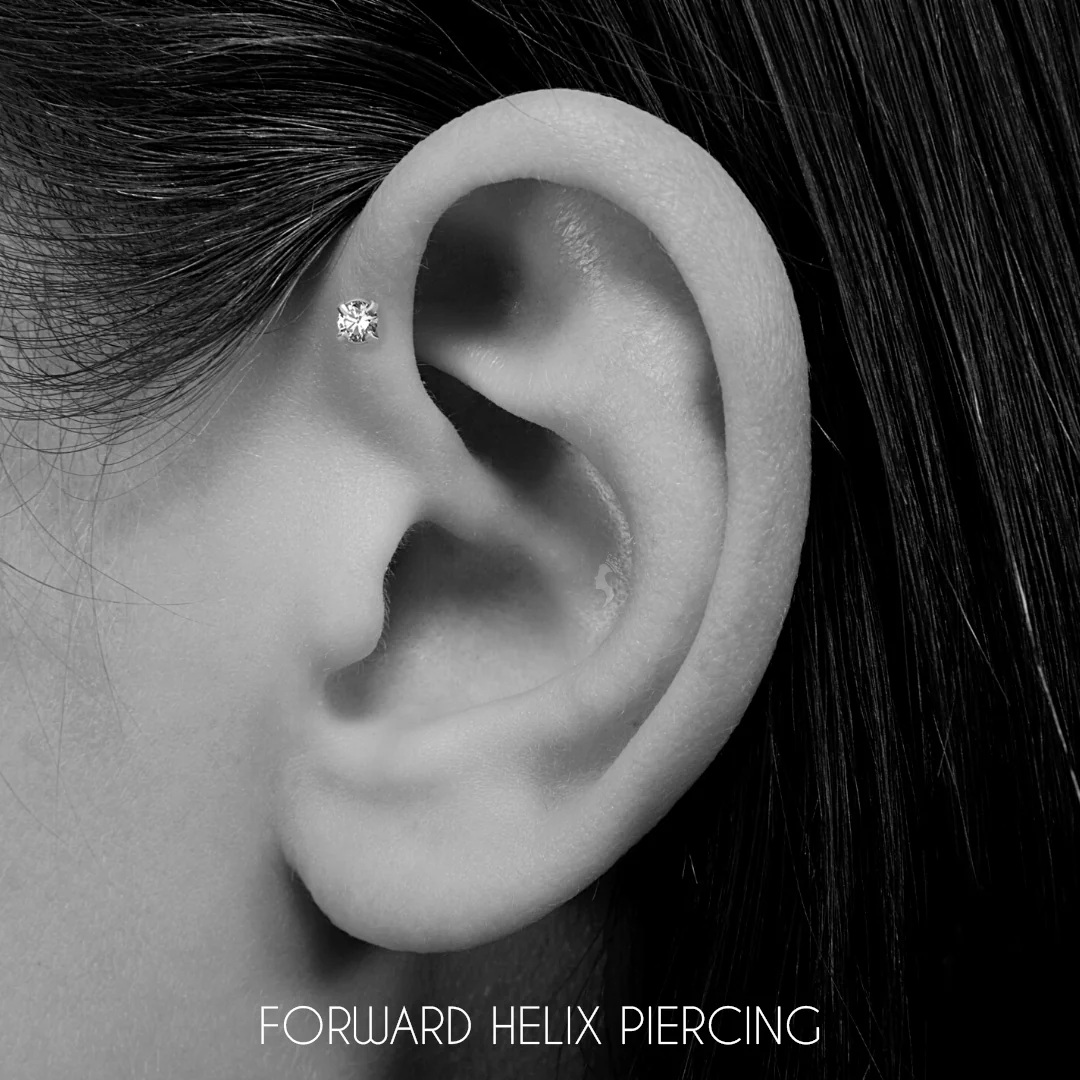
Anti-Helix Piercing
Elevate Your Ear Curation with a Forward Helix
The forward helix is a beautiful, modern piercing that can be the star of your ear project. When performed by a specialist who understands the importance of precise placement, it is a safe and stunning addition.

